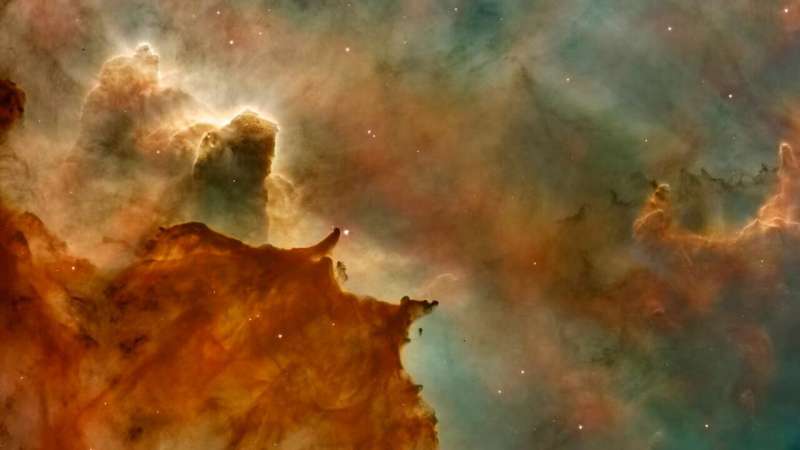December 19, 2023 feature
This article has been reviewed according to Science X's editorial process and policies. Editors have highlighted the following attributes while ensuring the content's credibility:
fact-checked
peer-reviewed publication
trusted source
proofread
The eBse model: A new perspective on dark energy and inflation

A new Scientific Reports study proposes an extension of the electron Born self-energy (eBse) model, unveiling a mechanism for cosmic inflation driven by a constant potential energy density, thereby challenging the conventional cosmological paradigm.
Dark energy is a mysterious force that permeates the universe, causing its expansion to accelerate. It constitutes about 68% of the total energy content of the cosmos.
Unlike dark matter, dark energy does not clump together but appears to be uniformly distributed. The nature of dark energy remains poorly understood, and it is often associated with the cosmological constant, represented by the Greek letter Λ.
Λ is a constant energy density in space, initially introduced by Einstein and later reconsidered to explain the observed accelerated expansion of the universe, often associated with dark energy.
Traditional cosmological models, such as the ΛCDM model, attribute dark energy to the energy of empty space. In this model, dark energy is considered as the intrinsic energy of the vacuum itself, driving the accelerated expansion of the universe observed in recent cosmological studies.
The eBse model, introduced by Dr. Bruce Law from Kansas State University, challenges this paradigm by introducing an alternative explanation for dark energy, proposing that the energy is associated with the electric field surrounding a finite-sized electron, a concept not considered in the traditional cosmological framework.
This departure from the conventional understanding prompts a reevaluation of the mechanisms underlying cosmic inflation and the nature of dark energy.
Cosmic inflation and the ΛCDM model
The author of the study, Dr. Law, explained to Phys.org, "In the standard cosmological paradigm, the expansion of the universe is explained using two separate and distinct theories: cosmic inflation, at early times, and the ΛCDM model, at later times."
Cosmic inflation proposes a rapid and exponential expansion of the universe in its early moments. This theoretical framework aims to address the shortcomings of the Big Bang by explaining observed large-scale homogeneity and isotropy of the universe.
Early in the universe's expansion history, when cosmic inflation is applicable, and temperatures are sufficiently high, photons are converted into electrons and positrons through a process known as creation.
Simultaneously, the reverse process (annihilation) occurs, where electrons and positrons annihilate into photons. A chemical equilibrium is established, maintaining a balance between the number of photons, electrons, and positrons in a given volume.
As the temperatures increase, reaching a glass transition temperature (TG), a phase transition occurs, causing the electron-positron plasma to fall out of equilibrium.
This glass transition temperature, described as TG = 1.06 × 1017K, marks a crucial point in the eBse model. Beyond TG, the universe undergoes exponential acceleration, characterized by a constant potential energy density.
The ΛCDM model, which encompasses the later stages of the universe's evolution, describes the large-scale structure by incorporating dark matter and dark energy.
In contrast, the eBse model challenges this paradigm by introducing a different mechanism for cosmic inflation.
The eBse model
Dr. Law introduced this model in 2020. He explained, "Picture intergalactic space today as a single hydrogen atom. This atom can be ionized (proton and electron) or un-ionized, wherein the ionization fraction (~50%) accounts for the electron's electric field, which is missing the ΛCDM model."
"My idea came from thinking that if electrons and positrons have a finite size, there should be changes in physics when tightly packed. So, I expanded the model to dense electron-positron scenarios to check its consistency with astrophysical observations."
The eBse model introduces a unique framework for comprehending cosmic inflation, identifying temperature (T) as the inflaton and the potential energy density ψ(T) as a plateau potential.
As the universe evolves, the temperature undergoes variations, influencing the behavior of the system. Concurrently, ψ(T) being characterized as a plateau potential (a relatively stable region in the potential energy landscape), suggests that the system remains relatively stable and exhibits a consistent potential energy state during this temperature span.
This distinctive perspective becomes particularly evident above the glass transition temperature (TG), where the eBse model naturally induces cosmic inflation, marked by exponential expansion.
Crucially, the plateau potential guides the system's behavior, ensuring stability within certain temperature ranges. The model seamlessly transitions to the ΛCDM model below a critical temperature (TX), forming a cohesive link between the early and later stages of the universe's evolution.
In contrast to traditional models, the eBse model effectively addresses drawbacks associated with cosmic inflation. It eliminates the need for fine-tuning parameters and offers explicit calculations for potential and kinetic energy densities, enhancing its explanatory power.
Validating the model and future work
Dr. Law emphasized, "My model (for the cosmic inflation period) is consistent with Planck collaboration 2013 findings for cosmic inflation. The Planck results arise from a detailed analysis of the temperature fluctuations within the cosmic microwave background (CMB). A sterner test of my model would be to compare it directly to the CMB temperature fluctuations."
Looking ahead, he sees the eBse model offering a comprehensive description of the universe's expansion history, challenging the Standard Model and the conventional cosmological paradigm.
Notably, the eBse model competes with the ΛCDM model, with comparisons against astrophysical measurements and a particular focus on CMB temperature fluctuations in the pipeline.
While the eBse model is promising, its current incompleteness prompts exploration, addressing issues like photonic transport and quantum fluctuations. Dr. Law acknowledges its oversimplified nature, emphasizing the ongoing journey toward refining and expanding this model.
The findings of the study are published in Scientific Reports.
More information: Bruce M. Law, Proposed physical mechanism that gives rise to cosmic inflation, Scientific Reports (2023). DOI: 10.1038/s41598-023-49106-0.
Journal information: Scientific Reports
© 2023 Science X Network




















